Servo Motor for Inkjet Printers
Introduction
It is well known that torque of stepper motor is big in slow speed but it will drop sharply after it reaches above 600RPM, making stepper motor cannot be applied on occasions with high speed motion. Moreover, since positioning defects of stepper motor when it stop working will cause location errors, it cannot meet requirements of modern inkjet printers on high speed and high efficiency any longer. However, servo motor has characteristics like rapid response, high speed and high positioning accuracy, thus modern inkjet printers generally select motors of this kind as cloth feeding motor and small panel control motor, thus forming the situation of the high and medium-end market which centers on alternating servo motor system.
Introduction of techniques
In the production process of PZT, it will have polarity disposal: Atomic charge of raw materials are forced to be arranged according to the designated direction. It is a crucial characteristic since when external electric field effect is added to polarized data, it will cause PZT have a physical transformation according to its direction definition, and it is the phenomenon that generate the function of jet. Cloth feeding motor is required to perform positive inversion; speed of cloth feeding and exiting should maintain stable; and it will clock automatically when stopped to prevent drop of cloth. Small panel control motor is required to have no vibrations in the process of moving and small panel should maintain enough strength when it is still. Requirements on servo property of jetting axis and cloth feeding axis is mainly because servo system has a higher dynamic response and a higher positioning accuracy. Full digital alternating servo drives have high speed frequency response and the function of resonance inhibition, and can adjust accurately and eliminate vibration. In addition, its control accuracy can reach to 1 pulse and the maximum input frequency can reach to 250Kpps. These can better guarantee drive needed by cloth feeding axis.
PZT is a solid solution of PbZrO3 and PbTiO3, and it has perovskite structure. PbTiO3 and PbZrO3 are typical representatives of ferroelectric substance and anti-ferroelectric substance since Zr and Ti belong to a same subgroup. PbTiO3 and PbZrO3 have similar space lattice form, but their macroscopic properties have big differences. Lead titanate is ferroelectric substance and its curie temperature is 492℃ while lead zirconate is anti-ferroelectric substance and its curie temperature is 232℃. Big difference as it is will be widely concerned by people.
Structure of equipment
Equipment system of inkjet printers has motion control board and servo motor control system, including servo control board, nozzle control panel and Ink supply system board, and the main control board is the USB interface. Jet drawing software generally adopts Monty jet drawing software which can accept Post Script documents, and TIFF, JPG and EPS drawing files. Motors of inkjet printers mainly include ink pump motor, track moving motor and pulling motor. An overall external view of transformed equipment is as shown in the following figure.

Setting of relevant parameters of ATO servo motor
| Function code | Set value | Remark |
| P4 | 0 | Selection of controlling mode, 0: position control |
| P2 | 400 | Selection of motor model |
| P10 | 2 | Mode of pulse input |
| P11 | 0/1 | Logical reversion of pulse input,can be used to change direction of motors |
| P12 | 1 | Pulse frequency multiplication molecules of input order |
| P13 | 1 | frequency multiplication denominators of input order |
Attentions
- When connecting power lines, they should correspond to terminals. It is not allowed to change phases to change direction of motor but adjustment of parameters could.
- When connecting control lines, the upper computer system and servo must connect with shield lines at least in one terminal to avoid disturbance of the outside to controlling signals.
- Wires must be rational and alternating current power supply must be strictly separated. Moreover, control lines must be separated from power lines and power supply lines of motors.

